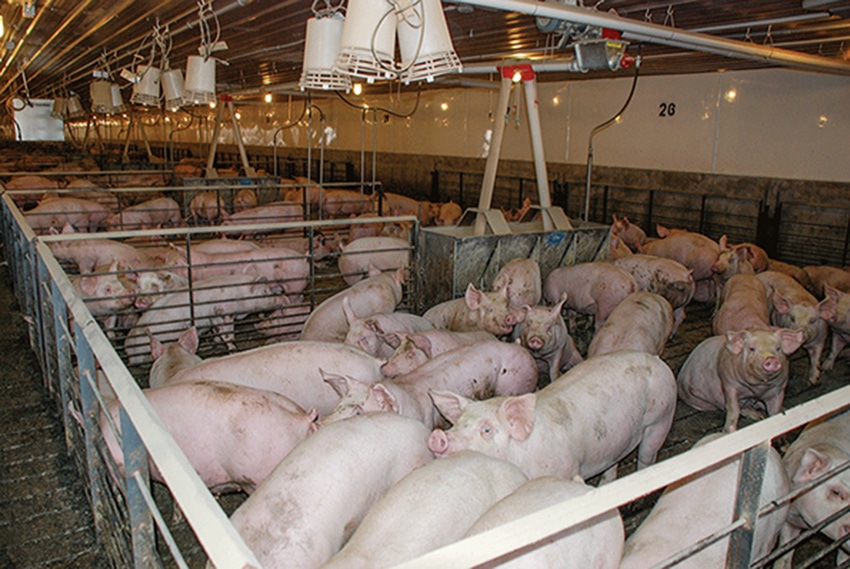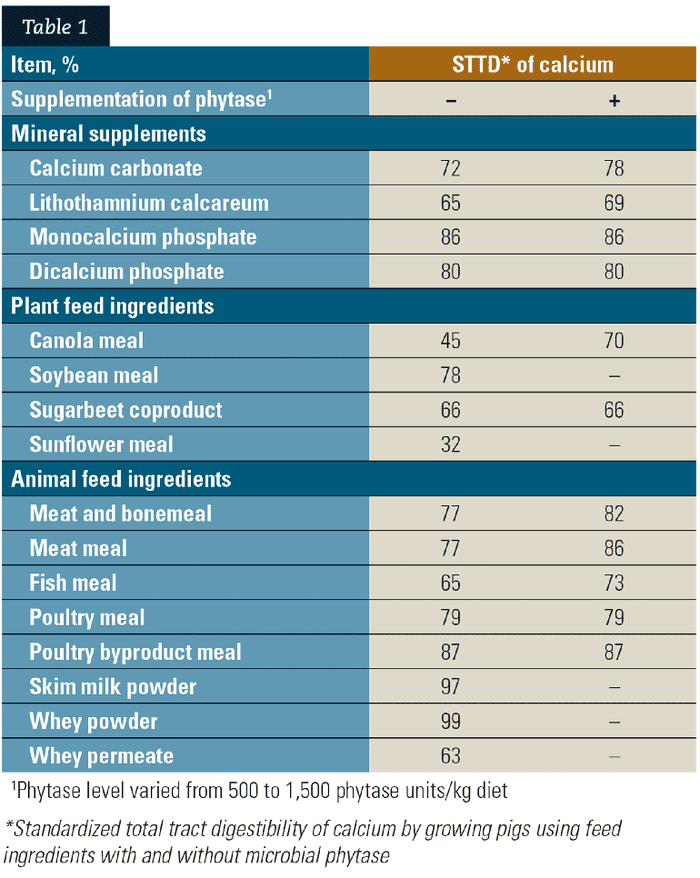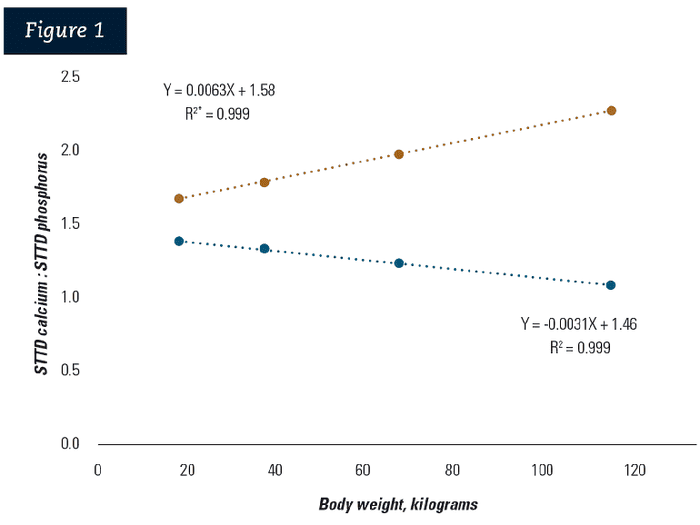Blueprint Issue: Finding bioavailability of digestible calcium and phosphorus.
July 3, 2019

By Su A Lee, L. Vanessa Lagos and Hans H. Stein
To evaluate the available phosphorus in inorganic P supplements, relative bioavailability of P has been measured, and the values were compared with the values from pigs fed monosodium phosphate or monocalcium phosphate.
Although only limited data for the bioavailability of calcium in inorganic supplements had been measured, it was assumed the availability of Ca in most Ca supplements was close to 100%. However, it was demonstrated that values for relative bioavailability of P are variable among standard phosphates, and the relative bioavailability of P is often greater than digestibility values; this makes values for the bioavailability of P difficult to compare from study to study.
Therefore, use of values for the digestibility of Ca and P has been suggested as a more accurate way to assess the digestibility of Ca and P in feed ingredients; and requirements for Ca and P by pigs may also be expressed on the basis of digestible Ca and P.
Feed ingredient digestibility
Digestibility represents the amount of a nutrient that disappears from the intestinal tract and is not excreted in excreta including ileal digesta or feces. To measure digestibility of Ca and P, the total tract digestibility method is used because there is no net absorption or secretion of Ca and P in the large intestine.
Apparent total tract digestibility can be calculated by simply knowing intake and output of the nutrient. The values for ATTD are usually influenced by dietary nutrient levels because not only dietary nutrients, but also nutrients of endogenous origin, are excreted in the fecal output — which may result in an underestimation of ATTD.
The endogenous loss is the basal endogenous loss that is an inevitable loss from the body related to dry matter intake, and a diet-specific endogenous loss that is influenced by dietary components. ATTD values can be corrected for either basal endogenous loss or total endogenous loss to calculate standardized total tract digestibility or true total tract digestibility, respectively.
Because the STTD or TTTD values are not affected by the level of nutrients in the diet, values for STTD and TTTD of Ca and P are additive in mixed diets, but that is not the case for values for ATTD. However, determination of TTTD values is tedious and expensive, and values are not always repeatable. As a consequence, mixed diets fed to pigs are most correctly formulated on the basis of STTD of Ca and P in each feed ingredient.
Most digestible Ca and a large proportion of digestible P in typical diets for pigs originate from mineral supplements, including Ca phosphates and Ca carbonate, but animal and plant origin ingredients may also provide Ca and P. Values for the STTD of P have been measured in most commonly used feed ingredients and are also published in some feed ingredient tables — including the tables published by the National Research Council (2012). Digestibility values for Ca have also been determined as indicated (see Table 1).

Phytate is a primary form for P in plants including cereal grains, pulse crops and oilseeds, the major feed ingredients in swine diets. Pigs are not able to use phytate-bound P due to the absence of phytase secreted into the intestinal tract. Therefore, the digestibility of P in plant feed ingredient is low, with STTD values usually ranging from 20% to 50%.
In addition, digestibility of Ca decreases by increasing dietary phytate because phytate can chelate Ca ions and form Ca-phytate compounds. Phytate from plant feed ingredients can bind to Ca ions from Ca carbonate or other feed ingredients and therefore reduce the digestibility of Ca. Results of resent research also indicate that endogenous Ca may bind to phytate in the intestinal tract, which precludes reabsorption of endogenous Ca.
However, the Ca that is chelated to phytate will be released if microbial phytase is added to the diet; and as a consequence, supplemental phytase increases both P and Ca digestibility. Ca and P in monocalcium phosphate and dicalcium phosphate appear not to chelate to phytate in the intestinal tract of pigs, and the digestibility of Ca and P in monocalcium phosphate and dicalcium phosphate is, therefore, not affected by microbial phytase.
Grow-finish pig requirement
The NRC (2012) adopted the concept of STTD of P in feed ingredients by pigs, and requirement estimates were also expressed in STTD P. A modeling approach was used to estimate the requirements for STTD P by growing-finishing pigs to estimate the STTD P requirement (%): STTD P requirement = 0.85 × [maximum whole-body P retention / 0.77 + 0.19 × dry matter intake + 0.007 × body weight]. The model was based on five assumptions: 1) 85% of the P requirement to maximize bone ash is enough to maximize growth performance; 2) there is a linear relationship between body P mass and body protein mass; 3) the efficiency of STTD P utilization for P retention is 77%; 4) the basal endogenous loss of P is 190 mg/kg dry matter intake; and 5) there is a daily minimum urinary loss of P of 7 mg/kg body weight (NRC, 2012).
Because of a lack of data for the digestibility of Ca in feed ingredients fed to pigs, Ca requirements were expressed based on total Ca by NRC (2012). The total Ca requirement for growing pigs was estimated by multiplying the STTD P requirement by 2.15 (the multiplier used by NRC). However, because STTD values for Ca in most calcium-containing feed ingredients are now available, studies have been conducted in recent years to determine requirements for digestible Ca in diets for growing pigs.
Results from these studies clearly indicated there are detrimental effects on growth performance of providing excess dietary Ca in diets for growing pigs. This is particularly true if the STTD P concentration is at or below the requirement; whereas if STTD P is above the requirement, pigs may tolerate excess Ca as well.
This observation highlights the importance of using the ratio between STTD Ca and STTD P to formulate diets for growing pigs. If diets contain excess Ca, growth performance of pigs may be improved either by adding extra digestible P to the diet or by reducing the amount of digestible Ca in the diet.
Impact of phytase
Because microbial phytase increases the digestibility of not only P, but also of Ca, and because the endogenous loss of Ca is reduced if phytase is added to the diet, it is important to take all the Ca-releasing effects of microbial phytase into account when diets are formulated.
In most cases, release of Ca by microbial phytase is 25% to 35% greater than the release of P. That means if a P release of 0.10% is expected by a certain amount of phytase in a diet, the release of Ca is at least 0.125% to 0.135%. Because of the detrimental effects of excess digestible Ca in the diet, it is key that the entire Ca-releasing effect of microbial phytase is taken into account in diet formulation to avoid reduced growth performance in the pigs.
Maximizing bone ash
Pigs continue to deposit Ca and P in bone tissue beyond the point when they have maximized growth performance. As a consequence, the quantities of Ca and P needed to maximize bone ash are greater than what is needed to maximize growth performance.
In a series of experiments, the required amounts of digestible Ca and digestible P that are needed to maximize both growth performance and bone ash were determined for pigs from 11 to 130 kg.
Results from these experiments indicate that the ratio between STTD Ca and STTD P needed to maximize growth performance decreases as the pigs get older, whereas the ratio needed to maximize bone ash increases as pigs increase body weight from 11 to 130 kg (Figure 1). The requirement for STTD Ca by growing-finishing pigs fed diets in which P is provided at the NRC requirement was also calculated.

Conclusion
Values for STTD of Ca and P in feed ingredients for pigs have been determined in recent years, and it has been demonstrated that the Ca-releasing effect of microbial phytase is greater than the P-releasing effect.
Diets for growing and finishing pigs should be formulated based on a ratio between STTD Ca and STTD P, because excess dietary Ca results in reduced growth performance.
Data from recent requirement studies indicate that the STTD Ca:STTD P ratio needed to maximize growth performance decreases as pigs grow, whereas the STTD Ca:STTD P ratio needed to maximize bone mineralization increases as the weight of the pigs increases.
It is, therefore, likely that pigs destined for the breeding herd need diets with a greater STTD Ca:STTD P ratio than terminal pigs.
Lee and Lagos are doctoral students who work with Stein, a professor, in the Hans H. Stein Monogastric Nutrition Laboratory in the Department of Animal Sciences at the University of Illinois.
Sources: Su A Lee, L. Vanessa Lagos and Hans H. Stein, who are solely responsible for the information provided, and wholly own the information. Informa Business Media and all its subsidiaries are not responsible for any of the content contained in this information asset.
You May Also Like



